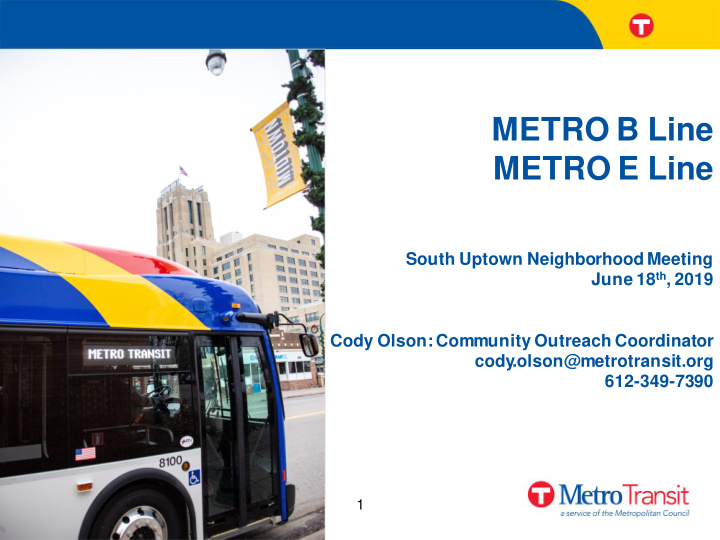



METRO B Line METRO E Line South Uptown Neighborhood Meeting June 18 th , 2019 Cody Olson: Community Outreach Coordinator cody .olson@metrotransit.org 612-349-7390 1
METRO BRT Stations
METRO BRT Buses Route 21 (Today): Front-door boarding, all fares collected on board B Line: All-door boarding, all fares collected at station
METRO B Line • Substantial upgrade, potential replacement of the Route 21 • Goal of approximately 20 percent faster by stopping less often, allowing customers to board faster, transit signal priority, and stopping at fewer red lights • B Line service every 10 minutes with improved buses and shelters
Route 21/53: Positives and Negatives Positives: Negatives 10,000 weekday rides on Route 21 (2 nd Average Route 21 spends 50% of its highest ridership). 700 daily on Route 53 time stopped In some places: Route 21 has 20% of Average speeds can be as slow as people in vehicles while being less than 8mph 2% of total vehicles Ridership has been declining Connects to important community destinations and other major transit routes
Potential downtown St. Paul terminus • Opportunities – Provide faster trips between downtown St. Paul, Selby Ave, Minneapolis – Further develop transitway network – Expand equitable access to destinations – Gold Line coordination/connections • Considerations – Relatively lower existing ridership east of Snelling – Project budget and operating costs 6
Preliminary Alignment Options 7
METRO E Line • Upgrade to Route 6 • The Corridor Study is evaluating routing and endpoint alternatives outside of the core Hennepin Ave segment. • The Corridor Study will determine the final alignment and concepts for local bus service.
Stop Spacing and Service Mix • Route 84 (A Line) and Route 16 (Green Line) have not kept pace with standards for ridership and productivity, leading to cuts • T o plan for a sustainable long term operation, considering fully replacing underlying local service – Must strike a balance between faster and more reliable service with spacing and accessibility • Wider stop placement – Reduced travel times, improved reliability, and smoother ride – Saves operating costs, allows Metro Transit to focus maintenance.
Recommend
More recommend